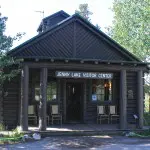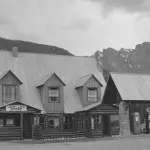The Jenny Lake area has been continuously used for thousands of years. Early Native Americans chose this ideal spot for their campsites, centrally located in the valley and with a plentiful water supply. It is no accident that the early European-American visitors who settled in the area also saw the same valuable resources in this location. As early as the 1890s, homesteaders began camping along Jenny Lake’s shores. Named for the wife of renown trapping guide, Richard “Beaver Dick” Leigh, (namesake of nearby Leigh Lake), this area remains one of the most popular tourist destinations in the valley. From archaeological sites to CCC structures, and Grand Teton National Park’s first visitor services headquarters, the lake has played a role in every chapter of history to touch the valley. Today, the lakefront looks very different from Beaver Dick and Jenny’s time, but the deep history remains present on the landscape.
1897: A fire sweeps through Jackson Hole, destroying almost all of the lodgepole pine resources in the valley.
The Teton Forest Reserve was established to manage the new growth lodgepole pine in Jackson Hole. The Reserve encompassed most of the northern portion of the valley, extending east from the Idaho border to the Gros Ventre River. The Teton Forest Reserve managed 892,440 acres, compared to 310,000 acres in current Grand Teton National Park.
1905: The Forest Service was created and adopted the policy that forest reserves should be promoted for their commercial and recreational values. They often leased out large tracts of land for mining, lumbering, irrigation and tourism purposes.
1906: At Jenny Lake, the Forest Service assumes management of a growing visitor services center.
1926: The Forest Service constructs a campground along the south-eastern shore of Jenny Lake to serve the growing number of visitors. This year 30,000 people would visit the Jackson Hole valley, and almost every one visited the Jenny Lake area.
1929: Grand Teton National Park was established. The original park only included the Tetons from the Idaho border east to Jenny Lake. The National Park Service assumes management of the Jenny Lake visitor services.
1930: The nearby Lee Mangus homestead was acquired by the NPS when the park was established. The Mangus cabin was moved to the southern Jenny Lake area in order to be used as a museum and ranger station. Fritiof Fryxell ran the museum, which housed the first interpretive exhibits on the park history and geology.
1931: Harrison Crandall also sold his homestead, located on the northern end of Jenny Lake, to the National Park Service. He moved his studio to the Jenny Lake visitor services area and became an integral part of the visitor interpretation of the park. Known as the “Park Photographer,” Crandall’s photos and paintings were in high demand and many visitors bought prints and cards as souvenirs.
1933: The CCC arrived in Jackson Hole, establishing a camp at Jenny Lake, just south of the visitor services complex and boat house area. They construct a tent camp with a mess hall and bathhouse.
1933-1940: The CCC expanded the campground‘s existing southern and northern loops with a new northern loop, creating a southern, central and northern loop. They constructed three comfort stations, one for each of the campground loops. The redesigned campsites included a fire pit, picnic table and graded tent platforms. The new campground was designed to be integrated into the natural environment, rather than in place of it.
1940: The CCC departs Jackson Hole and the buildings they used for their camp are removed. Only the mess hall and bathhouse remain. Both now house the Exum Climbing School.
1950-1960: The expansion of Grand Teton National Park meant that new visitor facilities were required in order to manage the expanded acreage. Visitor headquarters was moved to Moose, and facilities were constructed in Colter Bay. The Post Office and original store were closed, and converted into employee housing.
1958: Crandall retries and closes his studio. His 20-year contract with the NPS had expired and neither party chose to renew it. A new store was created in the empty space, mostly serving camping needs. It was later expanded into a general store to include small grocery items.
A log cabin was moved to the area where the museum, studio and comfort station were located. This building is assumed to be a residence for the ranger station which would open in the museum the next year.
1960: The museum closes when the visitor center moves to Moose. It is renovated into a ranger station, and serves this same purpose today.
1973: A windstorm blows down 80-90% of the trees in the southern portion of the campground area. Winds were estimated to be between 70-90mph. This storm would create big changes for the future of the campground and visitor complex. The buildings were now exposed and no longer hidden between the thick tree cover.
It was now evident how much use the area had experienced over the last several decades since the CCC left. There were user-created trails crisscrossing the area, eroding the soil and causing damage to vegetation. The shoreline was being misused, as many access trails had been created by visitors where they weren’t intended to be.
1973-Present: Jenny Lake continues to be one of the most popular visitor destinations in Grand Teton National Park. With the Jenny Lake Renewal Project, work continues today to update the facilities for increasing visitor demands. The current projects to revitalize the pathways and lakeshore access are scheduled to be completed in the spring of 2018.


